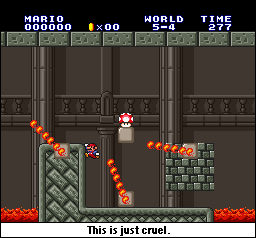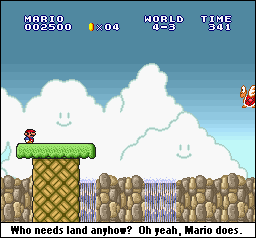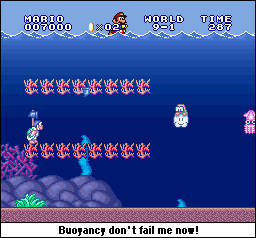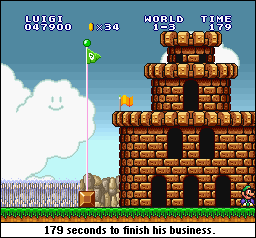They opted to keep virtually everything else the same. Oh, some of the backgrounds changed a little bit, and the mushrooms had eyes now, for whatever that was worth, but the core of the gameplay remained: you run around jumping on crap to beat a stage, with the ultimate goal being the rescue of Princess Peach Toadstool, who was again kidnapped by the evil King Bowser Koopa. Except, you know. Now it's hard.
 Now, the story goes that when Nintendo of America got their hands on this "Super Mario Bros. 2," they claimed it was too difficult for American audiences and hid the game away from our novice little eyes. I would like to present a slightly different point of view here. What Nintendo of America claimed firstly was that this game didn't actually bring any innovation to the Mario franchise, and innovation is what has always driven the company. It was the same old exercise again, just with different stages. And the second part of the claim, I believe, wasn't that the game was too difficult for an American audience, but rather that it was too difficult for any audience. That it was a mistake to release the game even in Japan, because it would provide nothing but a source of frustration to the hardcore gamers, and would totally alienate the casual ones. And as we view this game, one thing becomes undeniably clear: Nintendo of America was right.
Now, the story goes that when Nintendo of America got their hands on this "Super Mario Bros. 2," they claimed it was too difficult for American audiences and hid the game away from our novice little eyes. I would like to present a slightly different point of view here. What Nintendo of America claimed firstly was that this game didn't actually bring any innovation to the Mario franchise, and innovation is what has always driven the company. It was the same old exercise again, just with different stages. And the second part of the claim, I believe, wasn't that the game was too difficult for an American audience, but rather that it was too difficult for any audience. That it was a mistake to release the game even in Japan, because it would provide nothing but a source of frustration to the hardcore gamers, and would totally alienate the casual ones. And as we view this game, one thing becomes undeniably clear: Nintendo of America was right.Thus, the US didn't see this game until it was rereleased for the Super Nintendo as "Super Mario Bros.: The Lost Levels," as part of a collection of NES Mario games known as "Super Mario All-Stars." This is why the pictures you see here are of 16-bit quality rather than 8-bit; consumers in America had no other way to experience the game until very recently (and more on that later). So what was it about The Lost Levels that was so ridiculous?
 To begin with, take a look at this. Do you see a landing area? No. You do see a paratroopa, who flies up and down. You must time a jump perfectly so as to land on it and bounce to safety. And note that when you arrive at this area, you cannot even see the enemy at all. It's a blind jump, and you'll almost certainly miss and die when you take it. You have to stop all your momentum, inch the screen slowly to the right by manipulating the game's scrolling mechanism, then rebuild your momentum and jump at just the right instant to hit that koopa. This is on World 4-3, mind you. Not even halfway through the game. Similar blind jumps occur at other times, even requiring you to hit multiple successive koopas to get around. Alone it might seem an interesting challenge, but this is merely the tip of the iceberg.
To begin with, take a look at this. Do you see a landing area? No. You do see a paratroopa, who flies up and down. You must time a jump perfectly so as to land on it and bounce to safety. And note that when you arrive at this area, you cannot even see the enemy at all. It's a blind jump, and you'll almost certainly miss and die when you take it. You have to stop all your momentum, inch the screen slowly to the right by manipulating the game's scrolling mechanism, then rebuild your momentum and jump at just the right instant to hit that koopa. This is on World 4-3, mind you. Not even halfway through the game. Similar blind jumps occur at other times, even requiring you to hit multiple successive koopas to get around. Alone it might seem an interesting challenge, but this is merely the tip of the iceberg.In fact, the game lets you know right off the bat that you are screwed. World 1-1 instantly looks a bit trickier than you feel like a World 1-1 should, although it's not too terrible to anyone who's played the first game. Before long at all, you come across the trademark question mark boxes and hit a few, getting coins. Then you hit the last one and a mushroom comes up, so you grab it. And die. Because that mushroom just so happens to be poisonous, killing you on contact (or making you small again if you're big). Now, in the SNES version of the game, poison mushrooms have purple tops and are generally discolored in a clear manner, so once you know what they are you know to avoid them. But in the original NES (well, Famicom, but who cares) version of the game, the color difference was slight between a super mushroom and a poison mushroom. As if that weren't bad enough, later stages of the game are littered with invisible blocks containing the things. And these are strategically placed in spots that require precise jumps, such that you make your jump and are stopped halfway by an invisible mushroom of death. If the resulting fall doesn't kill you, the fungus almost certainly will.
 Let's jump ahead several tedious hours to the "end" of the game. When you finally defeat Bowser at the end of World 8-4 and save the Princess (who in the NES version is still a mutt), she again entreats you to "press start" for a more difficult quest. My inclination at this point was to tell her to shove it - the harder quest in Super Mario Bros. consisted of turning one kind of enemy into another and calling it a day, and I had no interest in wasting time on that. I pressed start anyway expecting a title screen, and it sent me to....World 9-1?! WORLD 9-1?!?! And it's a WATER LEVEL?!?!?!
Let's jump ahead several tedious hours to the "end" of the game. When you finally defeat Bowser at the end of World 8-4 and save the Princess (who in the NES version is still a mutt), she again entreats you to "press start" for a more difficult quest. My inclination at this point was to tell her to shove it - the harder quest in Super Mario Bros. consisted of turning one kind of enemy into another and calling it a day, and I had no interest in wasting time on that. I pressed start anyway expecting a title screen, and it sent me to....World 9-1?! WORLD 9-1?!?! And it's a WATER LEVEL?!?!?!"Yes!" says the game, "And I'll do you one better! This isn't just a water level...it's a water level with ground-based enemies! Haven't you always wanted to swim for dear life while Hammer Bros. and paratroopas and lakitus hunt you down like the felon you are? Haven't you always wanted to be completely defenseless while we defy all convention and physics with the sole purpose of murdering you repeatedly?"
No! I've never wanted any of that! It's so ridiculous that after the water levels of Worlds 9-1 and 9-2, in World 9-3, Bowser music starts playing. When you eventually find him he is inside a wall, completely invincible, happily chucking hammers at you. What. The. Hell. And then 9-4? Yep. Another water level. Uncalled for! Moreover, it is my understanding that in the NES version of the game, you had a single life to complete all four stages consecutively. No second chances. Furthermore! Completion of 9-4 sends you to World A-1. So they have to letter them now? I guess the hexadecimal coding would have thrown a fit with "10-1" or something. And the absurdity continues, as now squids will fly through midair and the like. And in the original version of the game, access to these "letter worlds" was granted only after beating the game eight times. Which of course, as you can tell from the existence of more levels, wasn't actually beating the game at all. You had to play the thing eight times just to finish it?! Why do that to your customers? Why?!
 Oh, and THIS GUY. Super Mario Bros. introduced the warp zone, but now you can get sent backwards? How twisted can you get? It's bad enough to play through any given stage once, but to send me back to do it all over again because I found a freaking bonus area is downright insulting. It's a cruel irony that the only solace to be found in this situation is to remember that eventually the clock will run out and you will die, so you can at least start at your current level, if you have the presence of mind to realize this before jumping into the pipe and wiping away all that hard work.
Oh, and THIS GUY. Super Mario Bros. introduced the warp zone, but now you can get sent backwards? How twisted can you get? It's bad enough to play through any given stage once, but to send me back to do it all over again because I found a freaking bonus area is downright insulting. It's a cruel irony that the only solace to be found in this situation is to remember that eventually the clock will run out and you will die, so you can at least start at your current level, if you have the presence of mind to realize this before jumping into the pipe and wiping away all that hard work.And hard work it is! Keep in mind that Super Mario Bros. had no save system whatsoever. The Lost Levels, appearing on the SNES, bucks that tradition and allows you to save at the beginning of each world. And when you lose all five of your starting lives (as you're quite unlikely to actually acquire more), you may continue from the stage on which you died as many times as you like so long as you don't quit the game. However, the NES version featured no saving capabilities, continues were offered only at the beginning of each world (as opposed to per stage), and you only started with three lives. That's three lives to get through four nightmarish levels each time. I can't call it impossible, but it's damn near it...certainly improbable at the very least. So yes, even when Nintendo of America DID decide to give us this game, they made it easier. And it's still quite possibly the hardest game I have ever completed.
 All kinds of challenges are implemented in this game, most of which are not possible to figure out the first time through, forcing you to replay entire levels and worlds. The game added wind effects, such that Mario can be blown off platforms to his death. You have to walk against the wind to stay on, but as you try to simply "treadmill" the effect by walking against the current, you inevitably hit that sudden moment at which you outwalk the wind and run off the opposite edge of the platform, again to your death. And most of these levels feature giant springs, which were never a fun part of the first game. But now they launch you entirely off the screen and you must traverse whole sections of the level with no real idea where you are, and land (in the wind) on a tiny platform with another such spring, and so on until level's end. It's a total pain, not enjoyable in the least, and often your descent is littered with flying enemies as well. What a waste of gameplay.
All kinds of challenges are implemented in this game, most of which are not possible to figure out the first time through, forcing you to replay entire levels and worlds. The game added wind effects, such that Mario can be blown off platforms to his death. You have to walk against the wind to stay on, but as you try to simply "treadmill" the effect by walking against the current, you inevitably hit that sudden moment at which you outwalk the wind and run off the opposite edge of the platform, again to your death. And most of these levels feature giant springs, which were never a fun part of the first game. But now they launch you entirely off the screen and you must traverse whole sections of the level with no real idea where you are, and land (in the wind) on a tiny platform with another such spring, and so on until level's end. It's a total pain, not enjoyable in the least, and often your descent is littered with flying enemies as well. What a waste of gameplay.There is at least one point at which you can literally not proceed with a level because you are guaranteed to take a hit and you are small Mario. And with no question boxes around, you have to sit there spending the first part of the stage jumping everywhere in sight until you find the invisible block with the super mushroom. Then you must retain your "bigness" until the part that is guaranteed to hurt you, and survive the remainder of the level as little Mario. I will note that this is in a castle stage, which also features a second Bowser. Yeah, that's right, you get to Bowser and get by him and there's another Bowser. Lovely.
And speaking of powerups, it wasn't until World 6-3 that I even saw a fire flower. I know because I marked the occasion specially. I was convinced for a while that they didn't even exist, because I figured they didn't need to. While poison mushrooms were plentiful (the game IS trying to kill you as often as possible, after all), super mushrooms were few and far between. Retaining one long enough to find another powerup block seemed unfathomable, so when I finally saw a fire flower I grabbed it right away, eager to have any extra edge. And of course, I fell into a bottomless pit ten seconds later on a rigged jump, designed specifically to kill you right after you get a powerup, because that crushes your dreams more than normal.
 As an added slap in the face, The Lost Levels did away with multiplayer. Sure, the two player mode on Super Mario Bros. only consisted of taking turns, waiting for one another to die so you could have a chance to play, but it was something. Here, in perhaps the game's only act of mercy, Nintendo decided that having more than one person experience this game at a time would be heinous. So instead, they offered a choice to play through the game as Luigi instead of Mario.
As an added slap in the face, The Lost Levels did away with multiplayer. Sure, the two player mode on Super Mario Bros. only consisted of taking turns, waiting for one another to die so you could have a chance to play, but it was something. Here, in perhaps the game's only act of mercy, Nintendo decided that having more than one person experience this game at a time would be heinous. So instead, they offered a choice to play through the game as Luigi instead of Mario.And this marked the first real difference in how the two characters played, establishing a precedent that would last to this day. While Mario played as always, Luigi actually jumped higher and farther than his older brother. This is naturally humiliating, because jumping is the only thing Mario is good for. He can even jump over the flag at the end of the levels as you see pictured above, which he does from time to time in order to take a dump on this deformity of a game. So you'd think playing the game as Luigi would be easier and a no-brainer, but of course it's not. To compensate for his extra jumping abilities, Nintendo made Luigi run slower and skid more. That is, when trying to slow down or change direction on the ground, Luigi is out of control for longer. So while you'll land the hard jumps a little easier, you'll also fall off platforms almost constantly, which makes it so that Luigi is probably an even worse choice than Mario in many cases. Still though, despite controlling a little more awkwardly, the ability to outjump Mario made Luigi a popular choice, and his more appealing color combination (to many gamers' eyes) meant perhaps Mario was going to have some competition for fans...
Now Nintendo has released The Lost Levels, in its original NES version, on the Wii's Virtual Console at a cost of $6. Is this a worthy investment? The answer is a resounding no. The game is like gargling a vial of acid while trying to play "Chopsticks" one-handed on a piano covered in tar. The easier SNES version is bad enough without actually PAYING for the earlier one. Its inclusion in a bundle of GOOD games is the only reason anyone should ever own it. Nintendo of America was right to keep this game from seeing the light of day...if only Nintendo of Japan had done the same thing.
Bottom Line: 4/20
No comments:
Post a Comment